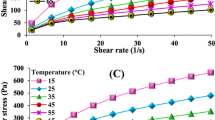Abstract
Introduction
The present work has evaluated the time-dependent and steady-state shear rheological properties of tomato juice.
Materials and Methods
Three models were compared for describing the shear stress decay during shearing (Figoni–Shoemaker, Weltman, and Hahn–Ree–Eyring), and the parameters of each model were empirically related with the shear rate.
Result
The three evaluated models, as well as their modification as function of shear rate, described well the experimental data of tomato thixotropy. The Herschel–Bulkley and Falguera–Ibarz models have shown to be very adequate to describe the data from steady-state shear. The obtained data are potentially useful for future studies on food properties and process design.






Similar content being viewed by others
References
Abu-Jdayil, B., Banat, F., Jumah, R., Al-Asheh, S., & Hammad, S. A. (2004). comparative study of rheological characteristics of tomato paste and tomato powder solutions. International Journal of Food Properties, 7(3), 483–497.
Altan, A., Kus, S., & Kaya, A. (2005). Rheological behaviour and time dependent characterization of gilaboru juice (Viburnum opulus L.). Food Science and Technology International, 11(2), 129–137.
Basu, S., Shivharey, U. S., Raghavan, G. S. V. (2007). Time dependent rheological characteristics of pineapple jam. International Journal of Food Engineering, 3(3), article 1.
Bayod, E., Mansson, P., Innings, F., Bergenstahl, B., & Tornberg, E. (2007). Low shear rheology of concentrated tomato products. Effect of particle size and time. Food Biophysics, 2, 146–157.
Barbana, C., & El-Omri, A. (2010). Viscometric behavior of reconstituted tomato concentrate. Food and Bioprocess Technology. doi:10.1007/s11947-009-0270-3.
Cepeda, E., Villarán, M. C., & Ibarz, A. (1999). Rheological properties of cloudy and clarified juice of Malus floribunda as a function of concentration and temperature. Journal of Texture Studies, 30, 481–491.
Choi, Y. H., & Yoo, B. (2004). Characterization of time-dependent flow properties of food suspensions. International Journal of Food Science & Technology, 39, 801–805.
Dak, M., Verma, R. C., Jaaffrey, S. N. A. (2008). Rheological properties of tomato concentrate. International Journal of Food Engineering, 4(7), article 11.
Falguera, V., & Ibarz, A. (2010). A new model to describe flow behaviour of concentrated orange juice. Food Biophysics, 5, 114–119.
Falguera, V., Vélez-Ruiz, J. F., Alins, V., & Ibarz, A. (2010). Rheological behaviour of concentrated mandarin juice at low temperatures. International Journal of Food Science & Technology, 45, 2194–2200.
Figoni, P. I., & Shoemaker, C. F. (1983). Characterization of time dependent flow properties of mayonnaise under steady shear. Journal of Texture Studies, 14, 431–442.
Genovese, D. B., & Rao, M. A. (2005). Components of vane yield stress of structured food dispersions. Journal of Food Science, 70(8), E498–E504.
Hahn, S. J., Ree, T., & Eyring, H. (1959). Flow mechanism of thixotropic substances. Industrial and Engineering Chemistry, 51, 856–857.
Haminiuk, C. W. I., Sierakowski, M. R., Izidoro, D. R., & Masson, M. L. (2006). Rheological characterization of blackberry pulp. Brazilian Journal of Food Technology, 9(4), 291–296.
Hayes, W. A., Smith, P. G., & Morris, A. E. J. (1998). The production and quality of tomato concentrates. Critical Reviews in Food Science and Nutrition, 38(7), 537–564.
Ibarz, A., & Barbosa-Cánovas, G. V. (2003). Unit operations in food engineering. Boca Raton: CRC.
Lozano, J. E., & Ibarz, A. (1994). Thixotropic behavior of concentrated fruit pulps. LWT Food Science and Technology, 27, 16–18.
Mizrahi, S. (1997). Irreversible shear thinning and thickening of tomato juice. Journal of Food Process and Preservation, 21, 267–277.
Nisha, P., Singhal, R. S., Pandit, A. B. (2010). Kinetic modelling of colour degradation in tomato puree (Lycopersicon esculentum L.). Food and Bioprocess Technology. doi:10.1007/s11947-009-0300-1.
Ramos, A. M., & Ibarz, A. (1998). Thixotropy of orange concentrate and quince puree. Journal of Texture Studies, 29, 313–324.
Rao, M. A. (1999). Flow and functional models for rheological properties of fluid foods. In M. A. Rao (Ed.), Rheology of fluid and semisolid foods: principles and applications. Gaithersburg: Aspen.
Ravi, R., & Bhattacharya, S. (2006). The time-dependent rheological characteristics of a chickpea flour dispersion as a function of temperature and shear rate. International Journal of Food Science & Technology, 41, 751–756.
Sato, A. C. K., & Cunha, R. L. (2007). Influence of temperature on the rheological behavior of jaboticaba pulp. Ciência e Tecnologia de Alimentos, 27(4), 890–896.
Sato, A. C. K., & Cunha, R. L. (2009). Effect of particle size on rheological properties of jaboticaba pulp. Journal of Food Engineering, 91, 566–570.
Silva, F. C., Guimaraes, D. H. P., & Gasparetto, C. A. (2005). Rheology of acerola juice: effects of concentration and temperature. Ciência Tecnologia de Alimentos, 25(1), 121–126. in portuguese.
Sun, A., & Gunasekaran, S. (2009). Yield stress in foods: measurements and applications. International Journal of Food Properties, 12, 70–101.
Tabilo-Munizaga, G., & Barbosa-Cánovas, G. V. (2005). Rheology for the food industry. Journal of Food Engineering, 67, 147–156.
Tiziani, S., & Vodovotz, Y. (2005a). Rheological characterization of a novel functional food: tomato juice with soy germ. Journal of Agricultural and Food Chemistry, 53, 7267–7273.
Tiziani, S., & Vodovotz, Y. (2005b). Rheological effects of soy protein addition to tomato juice. Food Hydrocolloids, 19(1), 45–52.
Tonon, R. V., Alexandre, D., Hubinger, M. D., & Cunha, R. L. (2009). Steady and dynamic shear rheological properties of açai pulp (Euterpe oleraceae Mart.). Journal of Food Engineering, 92, 425–431.
Vandresen, S., Quadri, M. G. N., Souza, J. A. R., & Hotza, D. (2009). Temperature effect on the rheological behavior of carrot juices. Journal of Food Engineering, 92, 269–274.
Vercet, A., Sánchez, C., Burgos, J., Montañés, L., & Buesa, P. L. (2002). The effects of manothermosonication on tomato pectic enzymes and tomato paste rheological properties. Journal of Food Engineering, 53, 273–278.
Weltman, R. N. (1943). Breakdown of thixotropic structure as function of time. Journal of Applied Physics, 14, 343–350.
Acknowledgments
Author PED Augusto thanks Fundación Carolina for the received fellow in the program “Movilidad de Profesores e Investigadores Brasil-España.”
Author information
Authors and Affiliations
Corresponding author
Rights and permissions
About this article
Cite this article
Augusto, P.E.D., Falguera, V., Cristianini, M. et al. Rheological Behavior of Tomato Juice: Steady-State Shear and Time-Dependent Modeling. Food Bioprocess Technol 5, 1715–1723 (2012). https://doi.org/10.1007/s11947-010-0472-8
Received:
Accepted:
Published:
Issue Date:
DOI: https://doi.org/10.1007/s11947-010-0472-8




